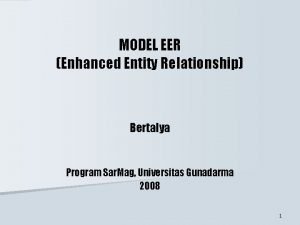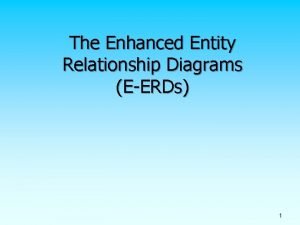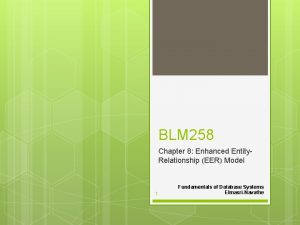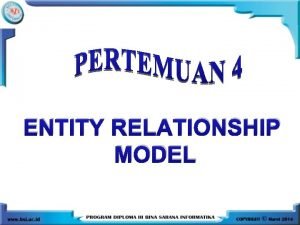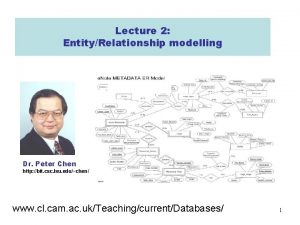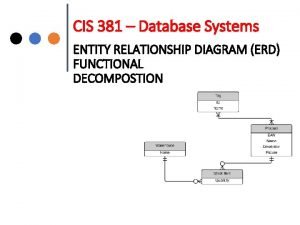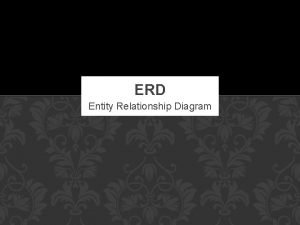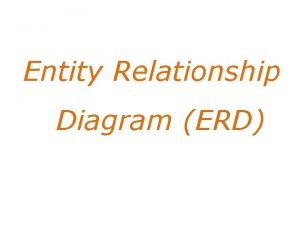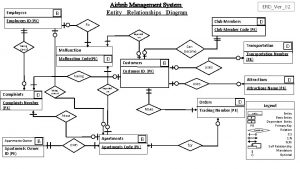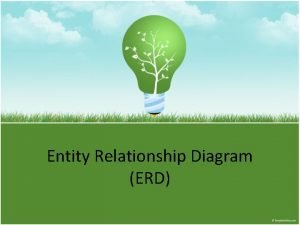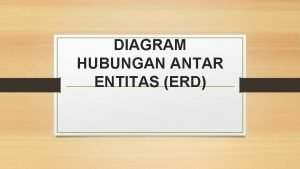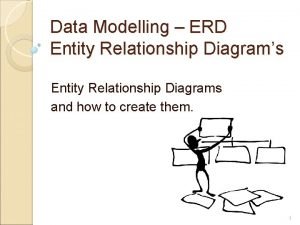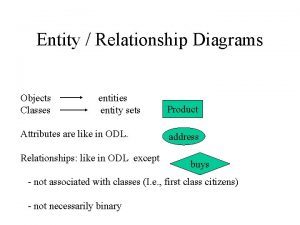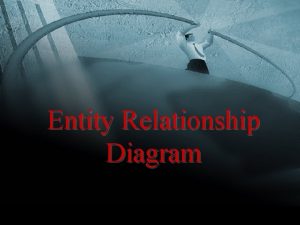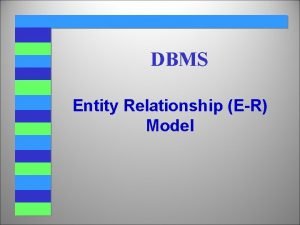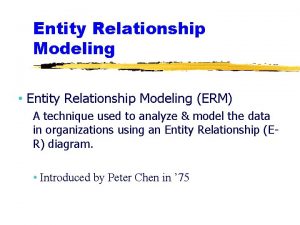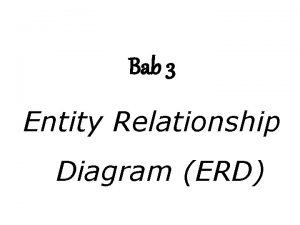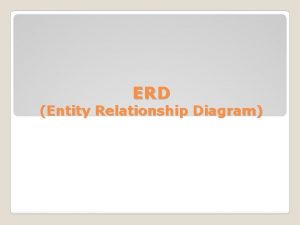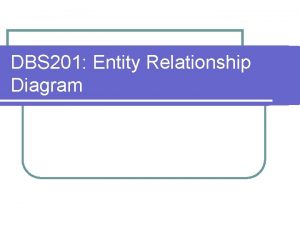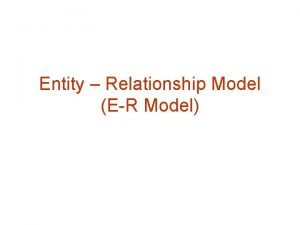The Enhanced Entity Relationship Diagrams EERDs 1 Supertypes






















- Slides: 22

The Enhanced Entity Relationship Diagrams (E-ERDs) 1

Supertypes and Subtypes n Subtype: A subgrouping of the entities in an entity n Supertype: A generic entity type that has a n Attribute Inheritance: type that has attributes distinct from those in other subgroupings relationship with one or more subtypes n n Subtype entities inherit values of all attributes of the supertype An instance of a subtype is also an instance of the supertype Chapter 4 © 2007 by Prentice Hall 2

Figure 4 -1 Basic notation for supertype/subtype notation a) EER notation Chapter 4 © 2007 by Prentice Hall 3

Figure 4 -1 Basic notation for supertype/subtype notation (cont. ) b) Microsoft Visio Notation Different modeling tools may have different notation for the same modeling constructs Chapter 4 © 2007 by Prentice Hall 4

Figure 4 -2 Employee supertype with three subtypes All employee subtypes will have emp nbr, name, address, and date-hired Each employee subtype will also have its own attributes Chapter 4 © 2007 by Prentice Hall 5

Relationships and Subtypes n n Relationships at the supertype level indicate that all subtypes will participate in the relationship The instances of a subtype may participate in a relationship unique to that subtype. In this situation, the relationship is shown at the subtype level Chapter 4 © 2007 by Prentice Hall 6

Figure 4 -3 Supertype/subtype relationships in a hospital Both outpatients and resident patients are cared for by a responsible physician Only resident patients are assigned to a bed Chapter 4 © 2007 by Prentice Hall 7

Generalization and Specialization n Generalization: The process of defining a more general entity type from a set of more specialized entity types. BOTTOM-UP n Specialization: The process of defining one or more subtypes of the supertype and forming supertype/subtype relationships. TOP-DOWN Chapter 4 © 2007 by Prentice Hall 8

Figure 4 -4 Example of generalization a) Three entity types: CAR, TRUCK, and MOTORCYCLE All these types of vehicles have common attributes Chapter 4 © 2007 by Prentice Hall 9

Figure 4 -4 Example of generalization (cont. ) b) Generalization to VEHICLE supertype So we put the shared attributes in a supertype Note: no subtype for motorcycle, since it has no unique attributes Chapter 4 © 2007 by Prentice Hall 10

Figure 4 -5 Example of specialization a) Entity type PART Only applies to manufactured parts Applies only to purchased parts Chapter 4 © 2007 by Prentice Hall 11

Figure 4 -5 Example of specialization (cont. ) b) Specialization to MANUFACTURED PART and PURCHASED PART Created 2 subtypes Note: multivalued attribute was replaced by an associative entity relationship to another entity Chapter 4 © 2007 by Prentice Hall 12

Constraints in Supertype/ Completeness Constraint n Completeness Constraints: Whether an instance of a supertype must also be a member of at least one subtype n Total Specialization Rule: Yes (double line) n Partial Specialization Rule: No (single line) Chapter 4 © 2007 by Prentice Hall 13

Figure 4 -6 Examples of completeness constraints a) Total specialization rule A patient must be either an outpatient or a resident patient Chapter 4 © 2007 by Prentice Hall 14

Figure 4 -6 Examples of completeness constraints (cont. ) b) Partial specialization rule A vehicle could be a car, a truck, or neither Chapter 4 © 2007 by Prentice Hall 15

Constraints in Supertype/ Disjointness constraint n Disjointness Constraints: Whether an instance of a supertype may simultaneously be a member of two (or more) subtypes Disjoint Rule: An instance of the supertype can be only ONE of the subtypes n Overlap Rule: An instance of the supertype could be more than one of the subtypes n Chapter 4 © 2007 by Prentice Hall 16

Figure 4 -7 Examples of disjointness constraints a) Disjoint rule A patient can either be outpatient or resident, but not both Chapter 4 © 2007 by Prentice Hall 17

Figure 4 -7 Examples of disjointness constraints (cont. ) b) Overlap rule A part may be both purchased and manufactured Chapter 4 © 2007 by Prentice Hall 18

Constraints in Supertype/ Subtype Discriminators n Subtype Discriminator: An attribute of the supertype whose values determine the target subtype(s) n n Disjoint – a simple attribute with alternative values to indicate the possible subtypes Overlapping – a composite attribute whose subparts pertain to different subtypes. Each subpart contains a boolean value to indicate whether or not the instance belongs to the associated subtype Chapter 4 © 2007 by Prentice Hall 19

Figure 4 -8 Introducing a subtype discriminator (disjoint rule) A simple attribute with different possible values indicating the subtype Chapter 4 © 2007 by Prentice Hall 20

Figure 4 -9 Subtype discriminator (overlap rule) A composite attribute with sub-attributes indicating “yes” or “no” to determine whether it is of each subtype Chapter 4 © 2007 by Prentice Hall 21

Figure 4 -10 Example of supertype/subtype hierarchy Chapter 4 © 2007 by Prentice Hall 22
 Contoh diagram eer
Contoh diagram eer Eer model
Eer model Eer vs erd
Eer vs erd Eerds
Eerds Enhanced entity-relationship
Enhanced entity-relationship Maksud dari shared-subclass pada model erd adalah
Maksud dari shared-subclass pada model erd adalah Simbol weak entity
Simbol weak entity Public interest entity
Public interest entity Public interest entity vs listed entity
Public interest entity vs listed entity Simbol weak entity
Simbol weak entity Use case model
Use case model Activity diagrams are static diagrams
Activity diagrams are static diagrams Peter chen diagram
Peter chen diagram Airbnb architecture diagram
Airbnb architecture diagram Erd supplier
Erd supplier Tujuan erd
Tujuan erd Entity relationship diagram video rental store
Entity relationship diagram video rental store Entity relationship data model
Entity relationship data model Contoh erd rumah sakit
Contoh erd rumah sakit Entity relationship adalah
Entity relationship adalah Airbnb er diagram
Airbnb er diagram Simbol simbol dalam erd
Simbol simbol dalam erd Diagram hubungan entitas
Diagram hubungan entitas
